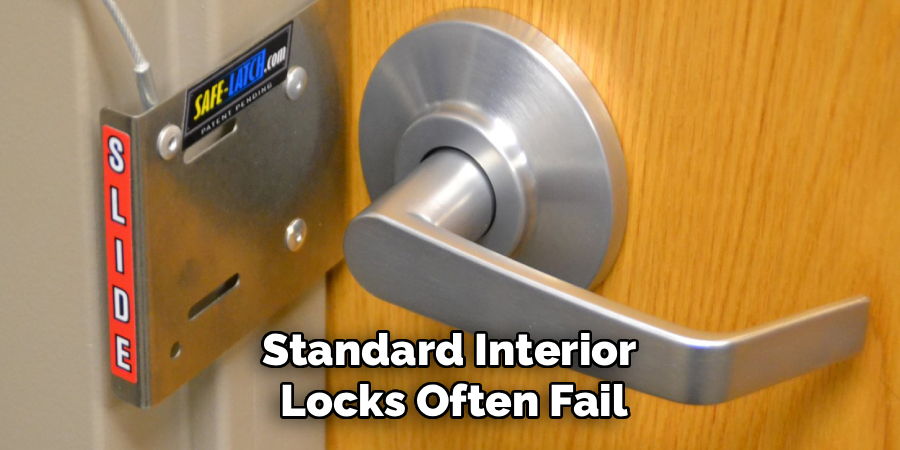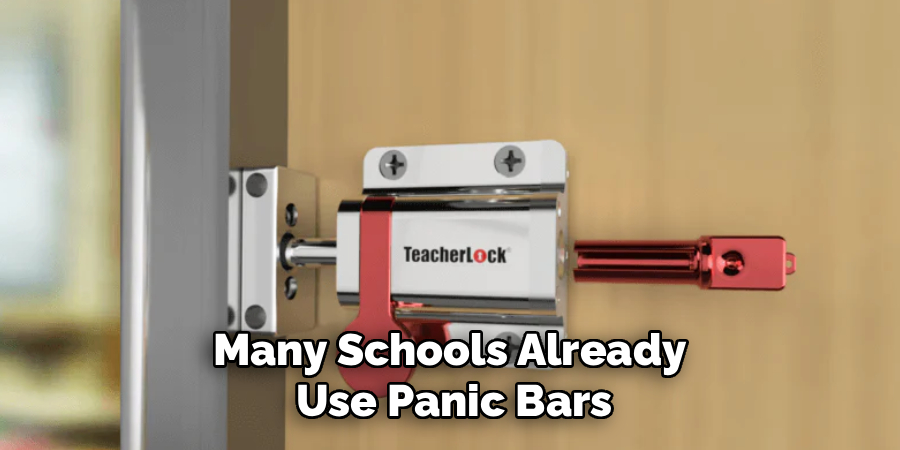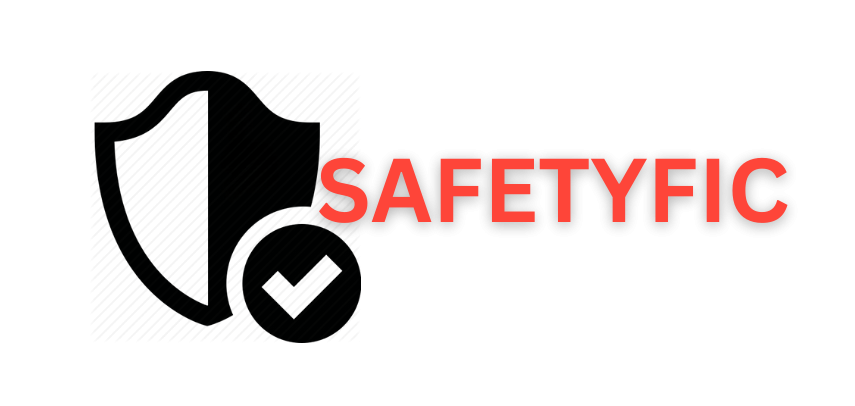When it comes to ensuring the safety of a classroom, securing doors that open outward presents unique challenges. Unlike inward-opening doors, which can often be barricaded with common objects, outward-opening doors require strategic solutions that account for both security and accessibility. This guide will provide an overview of how to secure a classroom door that opens outward.

Understanding the Security Risks of Outward-Opening Doors
Outward-opening doors, while commonly used for safety and accessibility reasons, come with their own set of security vulnerabilities. One key risk is that the hinges are exposed on the outside, making them susceptible to tampering or removal. Additionally, outward-opening doors cannot be easily barricaded from the inside, which can leave a classroom more vulnerable during an emergency lockdown.
These doors are also more difficult to modify with traditional security measures, as any changes must ensure compliance with fire and accessibility codes. Understanding these risks is a crucial first step toward implementing effective security solutions for outward-opening classroom doors.
Tools and Materials Needed
To enhance the security of outward-opening classroom doors, several tools and materials may be required, depending on the specific solution being implemented. Commonly needed items include:
- Heavy-duty door braces or jammers: Designed to prevent the door from being forced open.
- Door security bars: Adjustable bars that reinforce the door from the inside.
- Impact-resistant door shields or plates: To protect the hinges and surrounding areas from tampering.
- Reinforced hinge pins: To replace standard hinge pins and reduce the risk of removal.
- Emergency locking devices: Quick-deploy mechanisms for securing the door during a lockdown.
- Tools for installation: Such as drills, screwdrivers, and measuring tape, to properly install security devices.
- Compliance guides or documentation: To ensure that all modifications meet local fire and accessibility regulations.
Having these tools and materials ready can streamline the process of securing outward-opening doors while maintaining safety standards.
10 Methods How to Secure a Classroom Door that Opens Outward
1. Install a Surface-Mounted Deadbolt or Vertical Rod Lock
For outward-opening doors, standard interior locks often fail to prevent forced entry from outside. A surface-mounted deadbolt or vertical rod lock can be installed on the interior side of the door to provide additional reinforcement. These locks are mounted on the surface of the door and frame and engage with the frame above and below the door, creating a rigid barrier. Proper installation ensures the door cannot be pushed open, while still allowing emergency egress from the inside. This method is particularly effective for doors with metal or solid-core construction.

2. Use a Door Security Bar or Jammer
A door security bar is a simple yet highly effective method to secure outward-opening doors. Place the bar at an angle between the floor and the door handle or the push bar mechanism if the door has a panic exit feature. Many models are adjustable, allowing them to fit doors of varying heights and widths. The bar provides a mechanical barrier that prevents the door from being forced open, adding a strong layer of protection during emergencies or lockdown situations.
3. Reinforce Hinges With Security Pins
Outward-opening doors are vulnerable at the hinge side, as the pins can be removed from the exterior. Installing security hinge pins, also called non-removable hinge pins, ensures that the door cannot be lifted or removed from its hinges. These pins lock into place, preventing tampering from the outside. This simple modification strengthens the door and addresses a common vulnerability in outward-swinging doors, without altering the door’s function or emergency egress.
4. Install a Panic-Resistant Locking Mechanism
Many schools already use panic bars to meet fire code requirements. For added security, consider installing a panic-resistant lock that allows rapid exit from the inside but prevents unauthorized entry from outside. These mechanisms combine the safety of a panic bar with reinforced locking, ensuring that the door cannot be manipulated externally. Choosing a lock rated for educational environments ensures durability and reliability under high-traffic conditions.

5. Apply a Door Security Plate or Reinforcement Strike Plate
Reinforcing the door frame with a security plate or heavy-duty strike plate prevents forced entry through the lock area. Outward-opening doors are especially prone to kick-in attacks, and the use of a strong metal plate distributes the force across the frame, making the door more resistant to external pressure. This method is most effective when combined with deadbolts or vertical rod locks, creating multiple points of resistance.
6. Utilize Keyless Entry or Electronic Lock Systems
Keyless entry systems, such as keypad locks or RFID card readers, can enhance security for outward-opening classroom doors. These systems restrict access to authorized personnel only, while still allowing immediate exit from the inside in case of emergencies. Electronic locks also provide a record of entry and can be remotely controlled or overridden, making them particularly useful in schools where monitoring and access control are critical. Integration with the school’s security system adds an additional layer of safety.
7. Implement a Locking Mechanism at the Top or Bottom of the Door
Another method for securing outward-opening doors is the installation of locks at the top or bottom of the door. Top-mounted surface bolts or floor-mounted bars engage with the door frame or floor, preventing the door from being pushed open. These secondary locking points supplement the main lock and add redundancy to the security system. Properly installed, they allow quick disengagement from the inside while reinforcing the door against external manipulation.

8. Use Visual and Behavioral Security Measures
Securing a door is not only about hardware; behavioral protocols also play a vital role. Clearly communicating to students and staff that the door should remain closed and locked during class enhances security. Use signage to remind personnel not to prop the door open and establish lockdown procedures for emergencies. Combining physical security measures with behavioral strategies ensures that doors remain effective barriers even in dynamic school environments.
9. Install Window Security or Shatterproof Glass
Many outward-opening classroom doors include glass panels that, if broken, allow entry. Installing shatterproof or laminated glass prevents forced entry while still allowing visibility for supervision. For doors with existing glass, consider applying a security film that holds broken pieces in place. This method strengthens the door without obstructing light or visibility, ensuring both security and safety.
10. Conduct Regular Maintenance and Security Checks
Even the best security measures are ineffective if hardware fails or becomes loose. Regularly inspect all locks, hinges, bars, and electronic systems to ensure they function correctly. Tighten screws, replace worn components, and test emergency exits to confirm smooth operation. Routine maintenance, combined with periodic security drills, ensures that outward-opening classroom doors remain secure, reliable, and compliant with safety regulations.

Maintenance and Upkeep
Proper maintenance is essential to ensure the long-term reliability and safety of outward-opening classroom doors. Develop a schedule for frequent inspections to identify potential issues such as rust, wear, or alignment problems. Use high-quality lubricants on hinges to prevent stiffness and noise, and promptly address any identified wear-and-tear to avoid further damage.
Additionally, keep accurate records of all maintenance activities and repairs. This log will help track the lifespan of components and ensure compliance with safety standards. A proactive approach to upkeep not only extends the functionality of the doors but also reinforces the overall security measures in place.
Troubleshooting Common Issues
Despite regular maintenance, doors can still encounter problems that require immediate attention. One common issue is creaking or squeaking hinges, which can often be resolved by applying a high-quality lubricant. For doors that do not close properly, check for misaligned hinges or obstructions in the door frame. Warping due to temperature changes or moisture can also cause improper alignment, and this may necessitate sanding or replacing the affected components. If a door sticks or becomes difficult to open, inspect the tracks or guide mechanisms for debris or damage.
For doors with locking mechanisms, make sure the lock is free of dirt and grime, as this can impair its function—cleaning or replacing the locking system may be necessary. Addressing these problems promptly ensures the doors operate efficiently and maintain their intended security.
Conclusion
Securing a classroom door that opens outward requires a combination of hardware solutions, safety measures, and behavioral protocols. By installing surface-mounted deadbolts, security bars, hinge pins, and reinforced strike plates, you address the mechanical vulnerabilities of outward-swinging doors. Complementing these with panic-resistant locks, keyless entry systems, top and bottom locking mechanisms, and shatterproof glass further enhances security. Behavioral strategies, such as keeping doors closed and conducting security drills, provide an additional layer of protection.
Regular maintenance ensures that all systems function properly, offering a reliable defense that safeguards students and staff. By integrating these ten methods, schools can create a secure learning environment while maintaining emergency accessibility and compliance with fire safety regulations. Thanks for reading this blog post on how to secure a classroom door that opens outward! We hope you found it helpful and informative.
About
Safety Fic is a distinguished figure in the world of Diy design, with a decade of expertise creating innovative and sustainable Diy solutions. His professional focus lies in merging traditional craftsmanship with modern manufacturing techniques, fostering designs that are both practical and environmentally conscious. As the author of diy, Safety Fic delves into the art and science of Safety Fic-making, inspiring artisans and industry professionals alike.
Education RMIT University
(Melbourne, Australia) Associate Degree in Design (Safety Fic) Focus on sustainable design, industry-driven projects, and practical craftsmanship. Gained hands-on experience with traditional and digital manufacturing tools, such as CAD and CNC software.
Nottingham Trent University
(United Kingdom) Bachelor’s in diyfastly.com and Product Design (Honors) Specialized in product design with a focus on blending creativity with production techniques. Participated in industry projects, working with companies like John Lewis and Vitsoe to gain real-world insights.
Publications and Impact
In diy, Safety Fic his insights on indoor design processes, materials, and strategies for efficient production. His writing bridges the gap between artisan knowledge and modern industry needs, making it a must-read for both budding designers and seasoned professionals.
